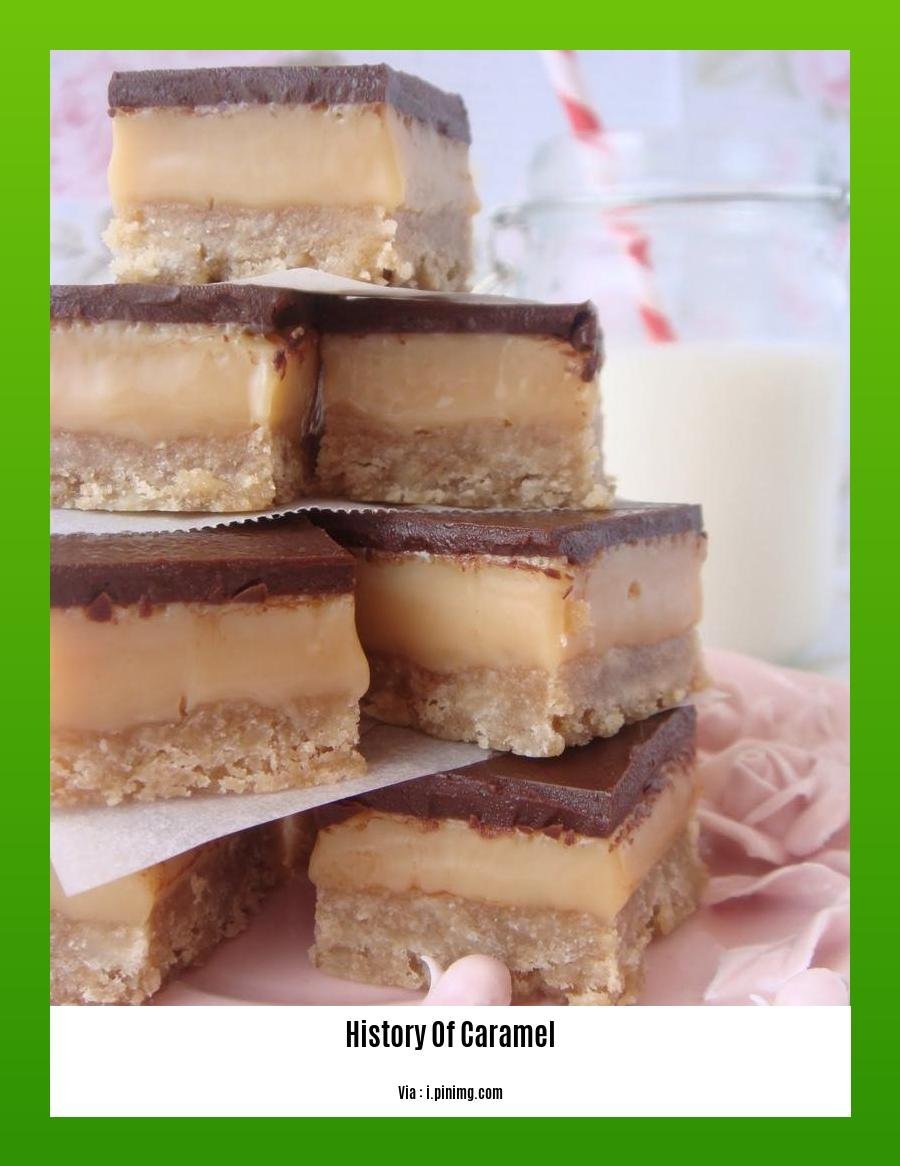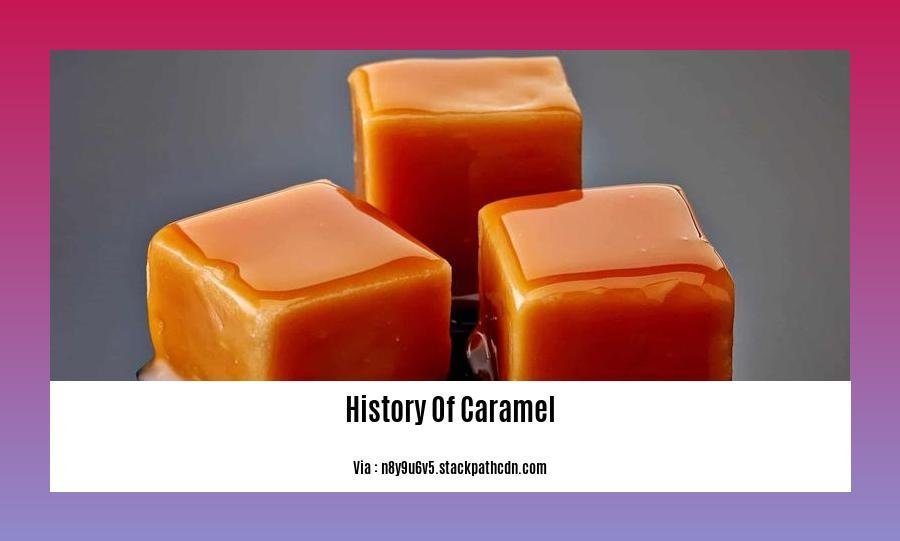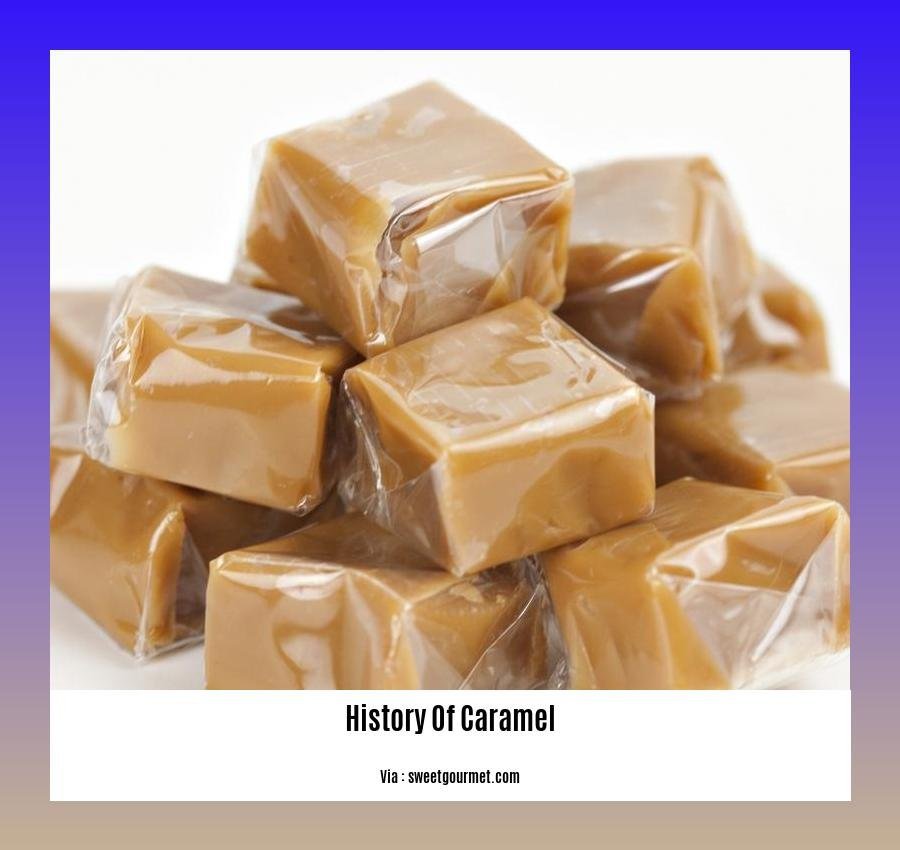Embark on a delectable journey through time as we unravel the fascinating history of caramel, a culinary masterpiece that has tantalized taste buds for centuries. From its humble beginnings as a sweet treat to its transformation into a versatile ingredient in modern confectionery, caramel’s story is one of innovation, cultural exchange, and pure indulgence. Discover how this golden-hued delicacy found its way into American kitchens, revolutionizing desserts and leaving an indelible mark on the culinary landscape. Join us as we explore the origins of caramelization, trace caramel’s evolution across continents, and uncover the secrets behind its irresistible allure. [A Culinary Journey Through Time: Unveiling the History of Caramel] promises a captivating exploration of this beloved confection.
Key Takeaways:
- Caramel is a confection made by heating and stirring a sugary syrup with milk and fat until it turns light brown.
- The exact origins of caramel are uncertain, but it is believed to have been first produced by Arabs around 1000 A.D.
- Modern caramel, as we know it, was developed in the late 1800s by confectioners who added milk and fat to a mixture of sugar or beet juice.
A Sweet History: Tracing the Roots of Caramel

Caramel, that luscious confection crafted from sugar’s embrace with heat and fat, boasts a heritage as rich and alluring as its taste. Its journey through time is a tapestry woven with culinary artistry, cultural exchange, and scientific discovery. Let’s embark on a culinary journey to unravel the history of caramel.
The Origins of Caramel: A Sweet Mystery
The exact birthplace of caramel remains shrouded in the mists of time. Some culinary historians trace its lineage to the Arab world, where skilled confectioners, using simple tools and a keen understanding of sugar’s properties, created a hard candy from boiling water and crystallized sugar around the 10th century.
A Culinary Evolution: Caramel’s Transformation
Centuries later, in Europe, caramel underwent a culinary metamorphosis. During the Middle Ages, sugar became more accessible, and European confectioners began experimenting with new techniques. They discovered that adding milk and fat to the sugar mixture created a softer, creamier confection—the caramel we know and love today.
The Industrial Revolution: Caramel’s Rise to Prominence
The Industrial Revolution ushered in an era of mass production, and caramel’s popularity soared. The invention of machinery for large-scale sugar refining made caramel more affordable, and it quickly became a staple in homes and confectioneries across the globe.
Caramel Today: A Versatile Culinary Star
In modern times, caramel’s versatility shines. It graces our tables in a myriad of forms—from the chewy sweetness of caramel candies to the velvety smoothness of caramel sauces and the rich filling of caramel-filled chocolates. It adds a touch of decadence to desserts, lends a luscious complexity to savory dishes, and even finds its way into beverages, captivating our taste buds with its unique blend of sweetness, richness, and complexity.
Caramel Through the Ages: A Timeline
To further illustrate caramel’s remarkable journey through time, let’s explore a brief timeline of its evolution:
| Era | Development |
|---|---|
| 10th Century | Possible origins in the Arab world, with the creation of hard candy from boiling water and crystallized sugar. |
| Middle Ages | Caramel’s introduction to Europe, where confectioners began adding milk and fat to create a softer, creamier confection. |
| Industrial Revolution | Mass production of caramel became possible with the advent of sugar refining machinery, making it more affordable and widely available. |
| Modern Times | Caramel’s versatility and popularity continue to grow, with its use in candies, sauces, desserts, savory dishes, and beverages. |
Conclusion
Caramel’s history is a testament to the enduring allure of this culinary treasure. Its journey from humble origins to global stardom speaks to its ability to capture our hearts and palates. Whether enjoyed as a sweet treat or incorporated into culinary creations, caramel remains a beloved ingredient, adding a touch of magic to our culinary experiences.
Discover the fascinating history of how Caribbean cuisine evolved into the vibrant and flavorful fusion it is today by reading the intriguing tale of how its culinary influences from all over the world merged into an explosive, delectable masterpiece. history of caribbean food
Delve into the rich history of Chicken Cordon Bleu, a dish that has captivated the taste buds of food enthusiasts for centuries. Discover how this iconic dish, with its tantalizing combination of succulent chicken, melty cheese, and crispy breading, became a culinary sensation loved by all. history of chicken cordon bleu
How Was Caramel Invented

Step back in time, my fellow culinary enthusiasts, as we uncover the intriguing story of caramel’s invention! This journey begins over 1000 years ago in the bustling kitchens of ancient Arabia, where culinary innovation thrived. It was here that alchemists of taste first stumbled upon the magical transformation of sugar and water into a crystallized liquid. This sweet, golden elixir, known as caramel, would embark on an extraordinary odyssey, shaping the culinary landscape of cultures across the globe.
Key Takeaways:
Caramel’s Origin: Caramel’s roots can be traced back to the Middle East, where it was first crafted by Arab confectioners using a simple blend of sugar and water.
Ancient Beauty Secret: Surprisingly, caramel’s initial purpose wasn’t culinary. It was prized as a beauty product, with women using it to create lustrous locks and enhance their skin’s radiance.
Evolution of Taste: Over time, caramel’s versatility was discovered, and it transitioned from a beauty enhancer to a culinary delight. It became a key ingredient in desserts, sauces, and beverages, captivating taste buds with its rich, buttery flavor.
Caramel’s Culinary Odyssey:
A Sweet Transformation: The creation of caramel begins with the heating of sugar, coaxing it to melt and caramelize under the watchful eye of culinary artists. This delicate process transforms sugar’s crystalline structure, creating a liquid amber with an alluring aroma.
The Science of Sweetness: As sugar heats, its molecules rearrange, breaking down and recombining to form new compounds that impart caramel’s characteristic flavor and color. The precise temperature and duration of heating determine the caramel’s shade, from a light golden hue to a deep, rich brown.
A Versatile Ingredient: Caramel’s culinary versatility is remarkable. It can be enjoyed on its own as a delectable candy, or incorporated into desserts like crème brûlée and sticky toffee pudding, adding a touch of decadence. It also enhances beverages, lending its sweetness and depth of flavor to lattes, cappuccinos, and the classic caramel macchiato.
In conclusion, caramel’s invention was a pivotal moment in culinary history, transforming a simple sugar syrup into a beloved delicacy. Its journey from ancient beauty secret to modern-day culinary superstar is a testament to the enduring power of culinary innovation. So, the next time you savor the rich, buttery taste of caramel, remember its captivating history and the alchemists of taste who first created this culinary treasure.
Sources:
[1] https://justfunfacts.com/interesting-facts-about-caramel/
[2]
History of Caramelization
Caramel, a confectionery delight, has a rich and intriguing history that spans centuries and regions. Embark on a culinary journey as we explore the origins, evolution, and cultural significance of this golden treat.
Key Takeaways:
- Caramel’s origins can be traced back to the Middle East, where it was initially used as a hair and skin enhancer.
- Its transition from beauty aid to culinary delight showcased its versatility and universal appeal.
- Caramel is crafted by heating sugar until it liquefies and caramelizes, creating an amber-colored liquid with a characteristic aroma.
- The precise temperature and duration of heating determine the shade and flavor intensity of caramel.
- Caramel’s popularity endures due to its rich, buttery taste, making it a beloved ingredient in desserts and beverages.
The Middle Eastern Roots
The history of caramel traces back over a thousand years to the Middle Eastern region. In its early form, it served not as a culinary treat but as a beauty enhancer, employed to lend luster to hair and skin. This unique application highlights caramel’s versatility, a characteristic that would later propel it to culinary stardom.
Transformation into a Culinary Delight
Caramel’s journey from beauty product to culinary delight showcases its adaptability and universal appeal. Its transition to the realm of taste can be attributed to its inherent sweetness and rich flavor profile. As people began experimenting with its culinary possibilities, caramel found its way into desserts, beverages, and sweets, capturing hearts and palates worldwide.
The Art of Caramelization
The essence of caramel lies in the process of caramelization, a delicate balancing act of heat and sugar. To achieve that perfect caramel, sugar is heated until it melts and undergoes a series of chemical transformations. As the temperature rises, the sugar molecules break down, releasing water and forming new compounds that give caramel its distinctive amber hue and rich flavor.
Shades of Caramel
The shade of caramel, ranging from pale gold to deep amber, is a testament to the precise temperature control involved in its creation. A lighter shade indicates a lower temperature and a shorter heating time, while a darker shade signifies higher heat and a more prolonged caramelization process. This variation in color directly impacts the flavor intensity, with darker caramels boasting a more pronounced bitterness.
Caramel’s Enduring Popularity
Caramel’s enduring popularity can be attributed to its rich, buttery taste and versatility in the culinary world. Its ability to enhance both sweet and savory dishes, from desserts to sauces, makes it a chef’s secret weapon. Caramel’s appeal extends beyond the kitchen; it’s a beloved ingredient in beverages, adding a touch of sweetness and a velvety texture to coffees, teas, and cocktails.
Embracing Caramel’s Allure
Caramel’s allure lies in its ability to elevate ordinary dishes into culinary masterpieces. Whether drizzled over ice cream, swirled into a crème brûlée, or incorporated into a decadent chocolate sauce, caramel adds a touch of indulgence and sophistication to any creation. Its versatility extends to savory applications as well, adding depth and richness to sauces, marinades, and glazes.
Conclusion
Caramel’s journey through time is a testament to its enduring appeal and versatility. From its humble beginnings as a beauty aid to its status as a culinary superstar, caramel has captured hearts and palates across cultures and generations. Its rich flavor, captivating aroma, and ability to transform ordinary dishes into extraordinary experiences ensure that caramel will continue to reign as a beloved confectionery delight for years to come.
Citations:
- A Brief History of Caramel – Cracker Box Palace
- The History of Caramel Candy | Our Everyday Life
FAQ
Q1: What is caramel?
A1: Caramel is a confection created by heating and stirring a sugary syrup with milk and fat until it takes on a light brown color.
Q2: How is caramel made?
A2: Caramel is made by heating sugar until it melts and then stirring it constantly until it reaches the desired color and flavor. Milk and fat are often added to create a smoother, creamier caramel.
Q3: What is the history of caramel in America?
A3: Caramel was first brought to America by European settlers in the 17th century. It quickly became a popular treat, and by the 19th century, caramel was being mass-produced in factories.
Q4: How was caramel invented?
A4: The exact origins of caramel are unknown, but it is believed that it was first created in the Middle East around 1000 AD. Caramel was originally used as a medicine, and it was not until the 19th century that it became a popular confection.
Q5: What is the history of caramelization?
A5: Caramelization is the process of heating sugar until it melts and turns brown. This process is responsible for the characteristic flavor and color of caramel. Caramelization was first discovered by ancient Egyptians, who used it to create a variety of confections.
- Senior at What Age: Benefits & Eligibility Guide - March 29, 2025
- Unlocking Senior Benefits: How Old is a Senior? Your Complete Guide - March 29, 2025
- Master Russian Politeness:A Guide to Saying Please - March 29, 2025
















